Tender Planning Phase
The Tender Planning phase is where Aetheron Response analyses your uploaded RFT document and helps you make strategic decisions about your tender response. This phase includes requirements extraction, bid/no-bid decision analysis, and win strategy development.
Overview of Tender Planning
What Happens in Planning Phase
The planning phase consists of three main steps:
- Requirements Analysis: AI extracts and categorises all tender requirements
- Bid Decision Assessment: AI evaluates your capability to win and recommends bid/no-bid
- Win Strategy Development: AI suggests strategic themes and competitive positioning
Purpose of Each Step
- Requirements: Ensures nothing is missed and all requirements are addressed
- Bid Decision: Helps you make informed decisions about pursuing the opportunity
- Win Strategy: Provides strategic foundation for compelling content creation

Step 1: Requirements Analysis
What Requirements Analysis Does
The AI system performs comprehensive analysis of your RFT document:
-
Extracts all requirements: Identifies mandatory and desirable requirements
-
Categorises by type: Groups requirements by themes and compliance levels
-
Prioritises by importance: Highlights critical requirements for success
-
Assigns compliance types: Marks requirements as mandatory, weighted, or informational
Reviewing Extracted Requirements
You'll see requirements organised by:
Requirement Categories
Each requirement shows:
- Requirement ID: Unique identifier (e.g., RFT-INF-001, RFT-INF-002)
- Title: Clear, descriptive requirement name
- Description: Detailed explanation of what's required
- Priority Level: High, Medium, or Low priority
- Compliance Type: Mandatory, Weighted (desirable/optional), or Informational
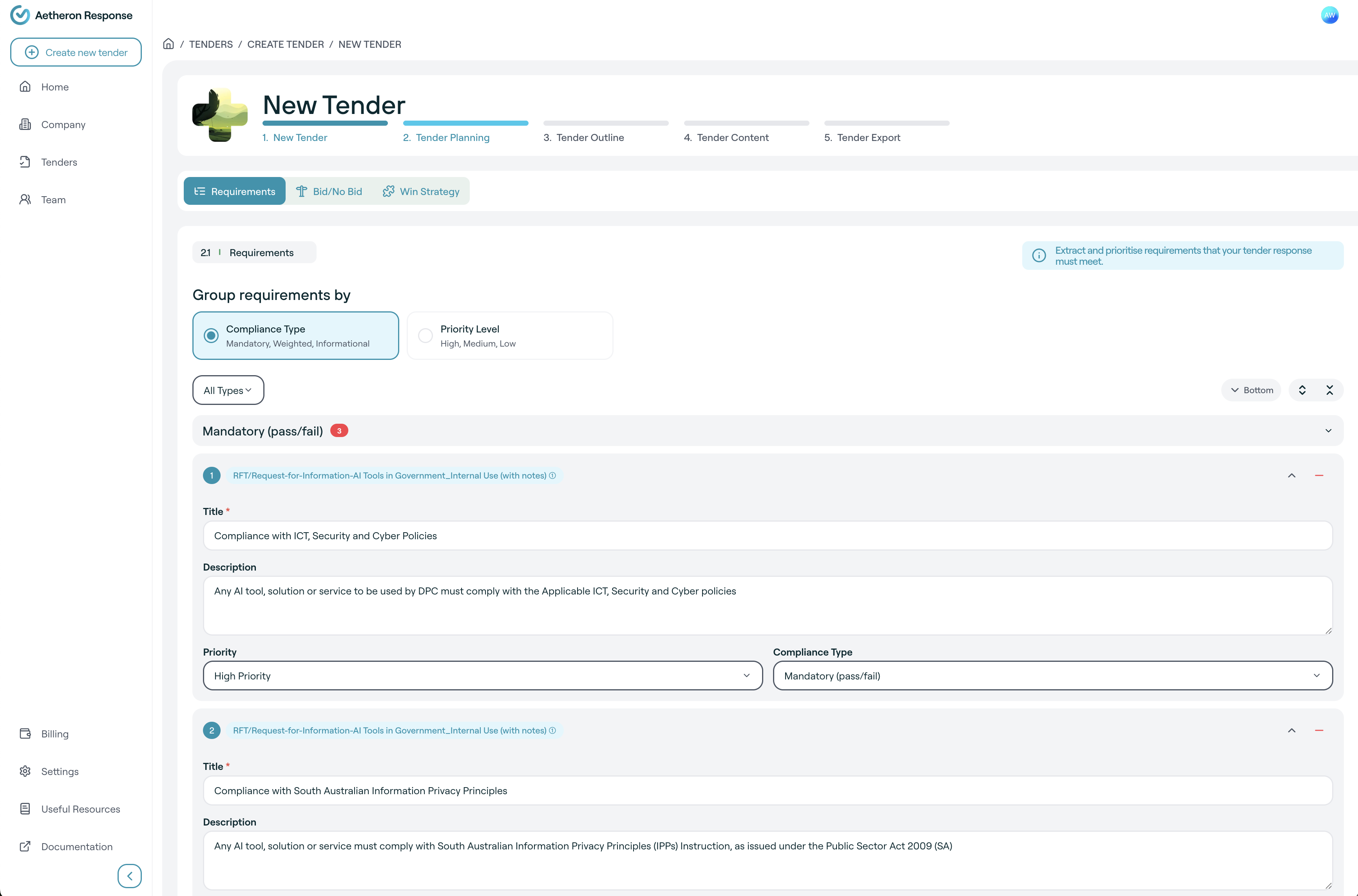
Example Requirements Display
Based on the tender planning process, you might see:
RFT-INF-001: Contract Duration - 3+1+1 Year Structure
- Description: Contract duration of 3 years with two 1-year extension options (3+1+1 structure)
- Priority: High Priority
- Compliance Type: Informational
RFT-INF-002: Contract Value Range - AUD 45-60 Million
- Description: Estimated contract value of AUD 45-60 million over initial 3-year term
- Priority: High Priority
- Compliance Type: Informational
RFT-WTD-150: Extract Major Evaluation Criteria
- Description: Identify weighted scoring criteria that significantly impact evaluation, key differentiators the buyer is looking for, performance metrics and SLAs that will be scored, and content requirements and information to include
- Priority: High Priority
- Compliance Type: Weighted (desirable/optional)
Requirements Management Tools
The interface provides tools to:
- Filter by type: View only mandatory, weighted, or informational requirements
- Sort by priority: Organise requirements by importance level
- Search requirements: Find specific requirements by keyword
- Add custom requirements: Include additional requirements you've identified
Reviewing and Validating Requirements
Your role in requirements review:
- Verify completeness: Ensure AI found all important requirements
- Check accuracy: Confirm requirement descriptions are correct
- Add missing items: Include any requirements the AI may have missed
- Prioritise correctly: Adjust priority levels if needed
Step 2: Bid Decision Assessment
AI-Powered Bid Analysis
Aetheron Response evaluates multiple factors to recommend whether you should bid:
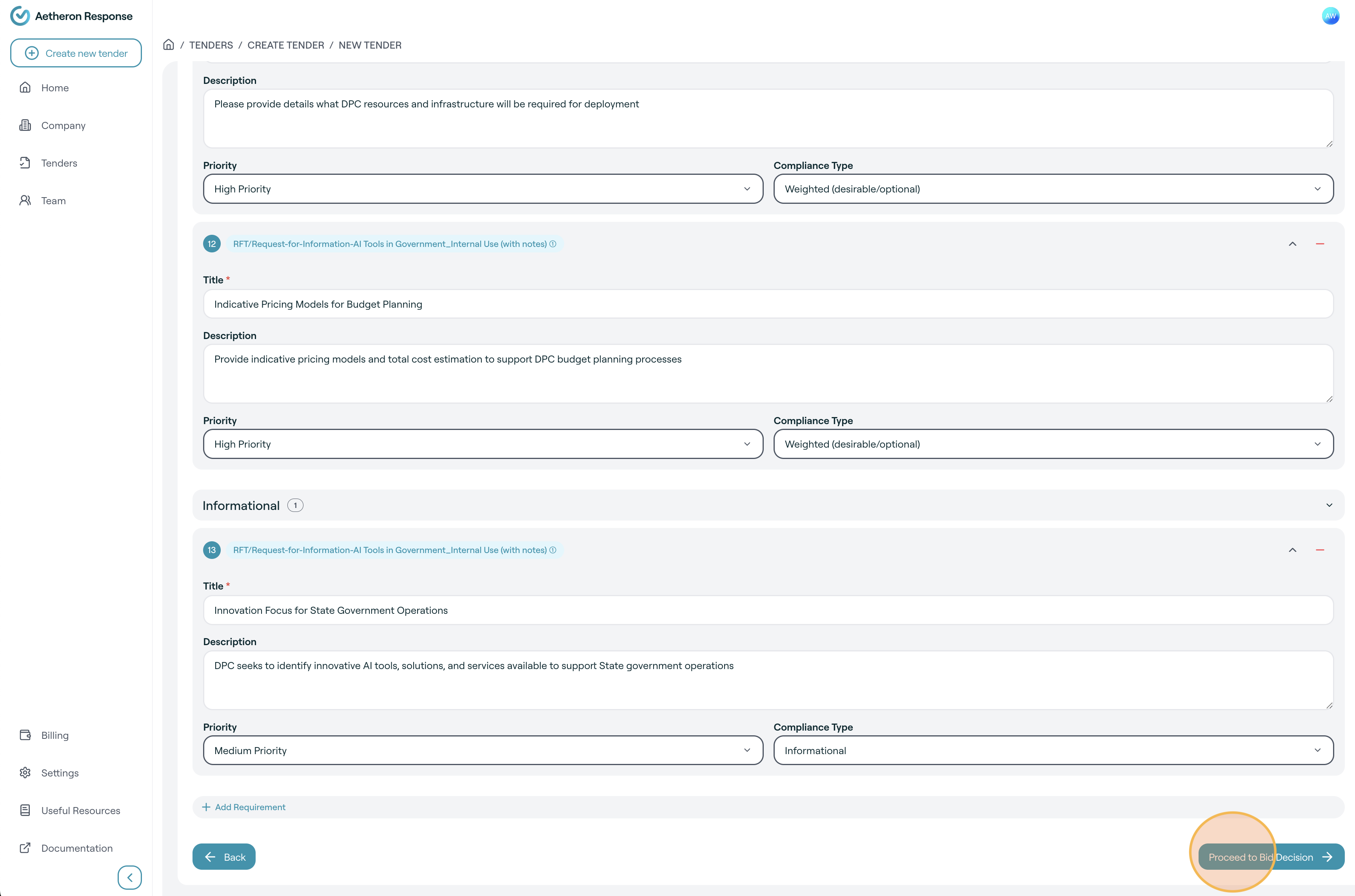
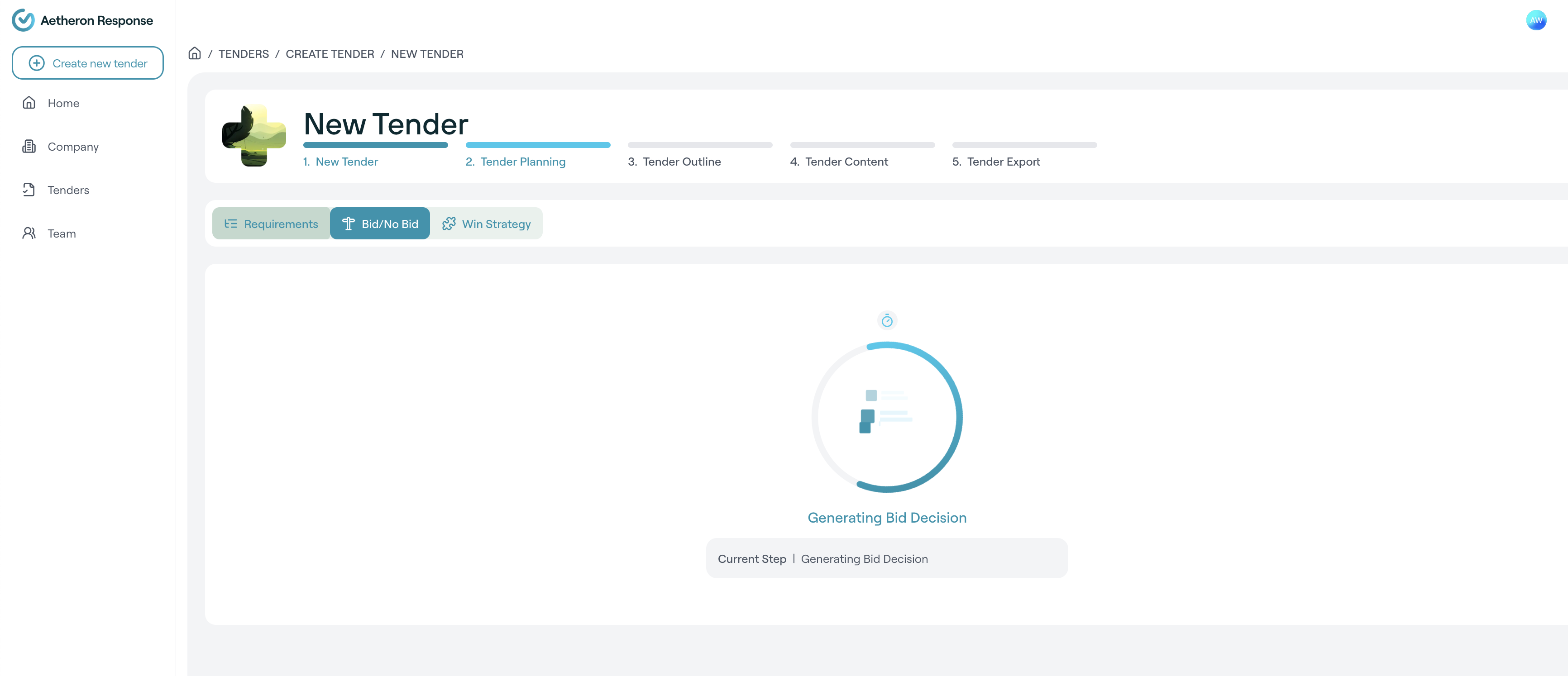
Assessment Parameters
The system analyses:
- Customer Relationship: Existing relationships, past performance, access to decision makers
- Strategic Alignment: Alignment with business strategy, market priorities, growth objectives
- Competitive Positioning: Competitive landscape, differentiating strengths, prime vs. sub positioning
- Solution Capability: Requirements coverage, expertise availability, similar experience
- Resource Availability: Staff availability, project size fit, external resource needs
- Profitability Potential: Profit margin expectations, payment terms, future opportunities
Scoring Methodology
Each criterion is scored from 0-5:
- 5/5: Excellent position or capability
- 3.5/5: Good position with some advantages
- 0/5: No position or significant disadvantages
Total Score Calculation
- Individual scores are weighted by importance
- Weighted scores are combined for overall assessment
- Total percentage indicates overall bid attractiveness
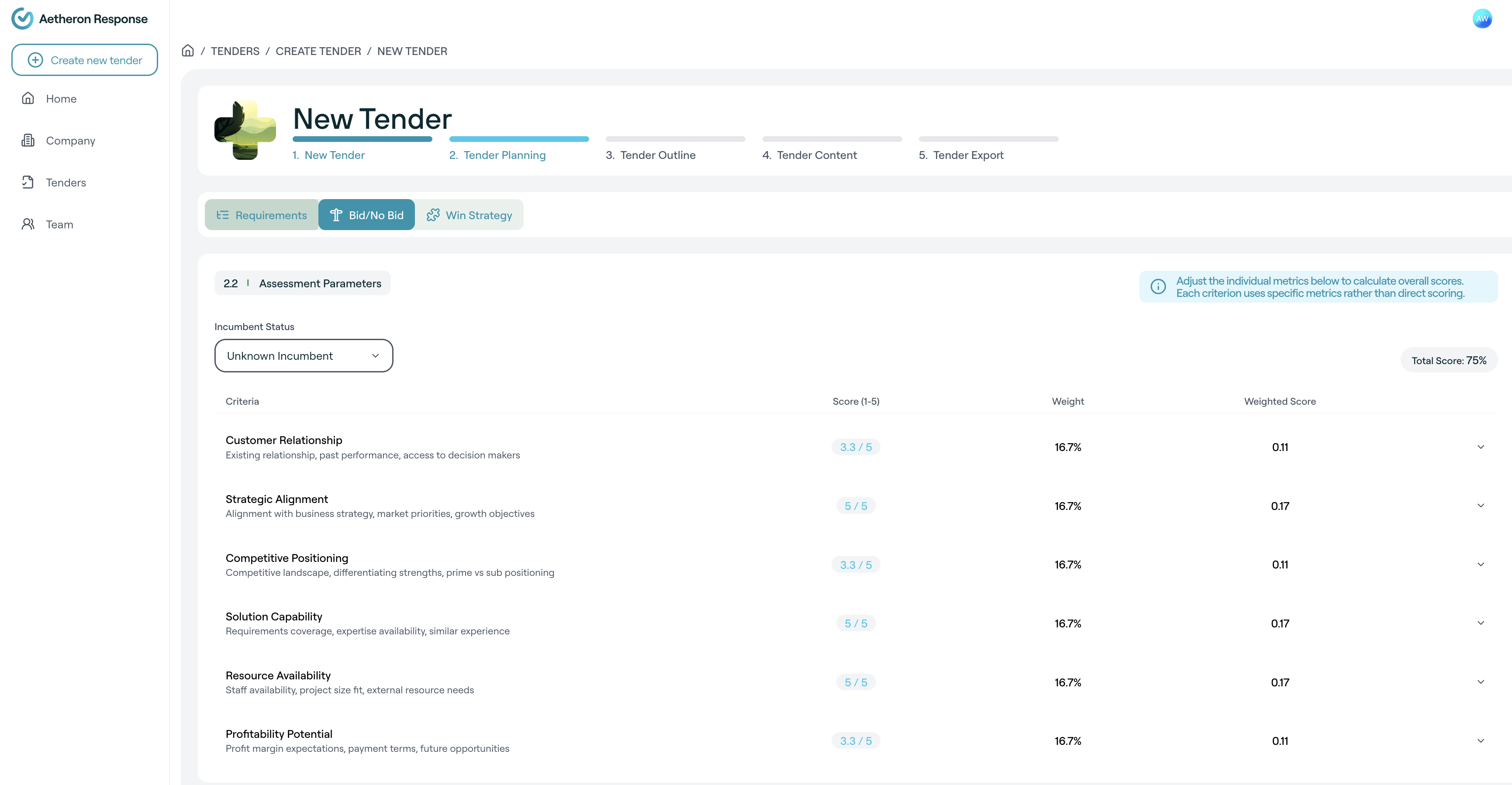
AI Recommendation
Based on the analysis, you'll receive:
Recommendation Types
- ✅ Recommended to Bid: Strong position with good win probability
- ⚠️ Conditional Bid: Moderate position requiring specific actions
- ❌ No Bid Recommended: Weak position with low win probability
Example Assessment Results
AI Recommendation: ✅ Recommended to Bid
- Analysis Complete - BID
- Total Score: 65% (indicating moderate to good bid position)
Key Strengths and Concerns
The AI provides detailed analysis including:
Key Strengths
Examples of positive factors:
- Strong presence in all major Australian cities mentioned in the RFT
- Established heritage as a leading national footprint provider
- Company operates as a specialised Managed Service Provider (MSP) since 2008
- Direct alignment with RFT requirements in specified geographic areas
- Over 800 clients across Australia and New Zealand, demonstrating scale and experience
Key Concerns
Examples of risk factors:
- No evidence of mandatory security clearances, government certifications (ISO 27001: SOC 2 Type II), or Essential Eight compliance capabilities
- Company profile lacks specific details on team size, annual revenue, and financial capacity
- Calculated score of 0.65 indicates moderate alignment with RFT requirements, suggesting significant gaps in technical capabilities, security posture, or service delivery model
Risk Mitigation Strategies
For each concern, the AI suggests mitigation approaches:
- Immediate actions: Steps you can take to address gaps
- Partnership opportunities: Strategic relationships to strengthen position
- Capability development: Areas requiring investment or enhancement
Step 3: Win Strategy Development
Strategic Theme Generation
After bid decision, Aetheron Response develops win themes:
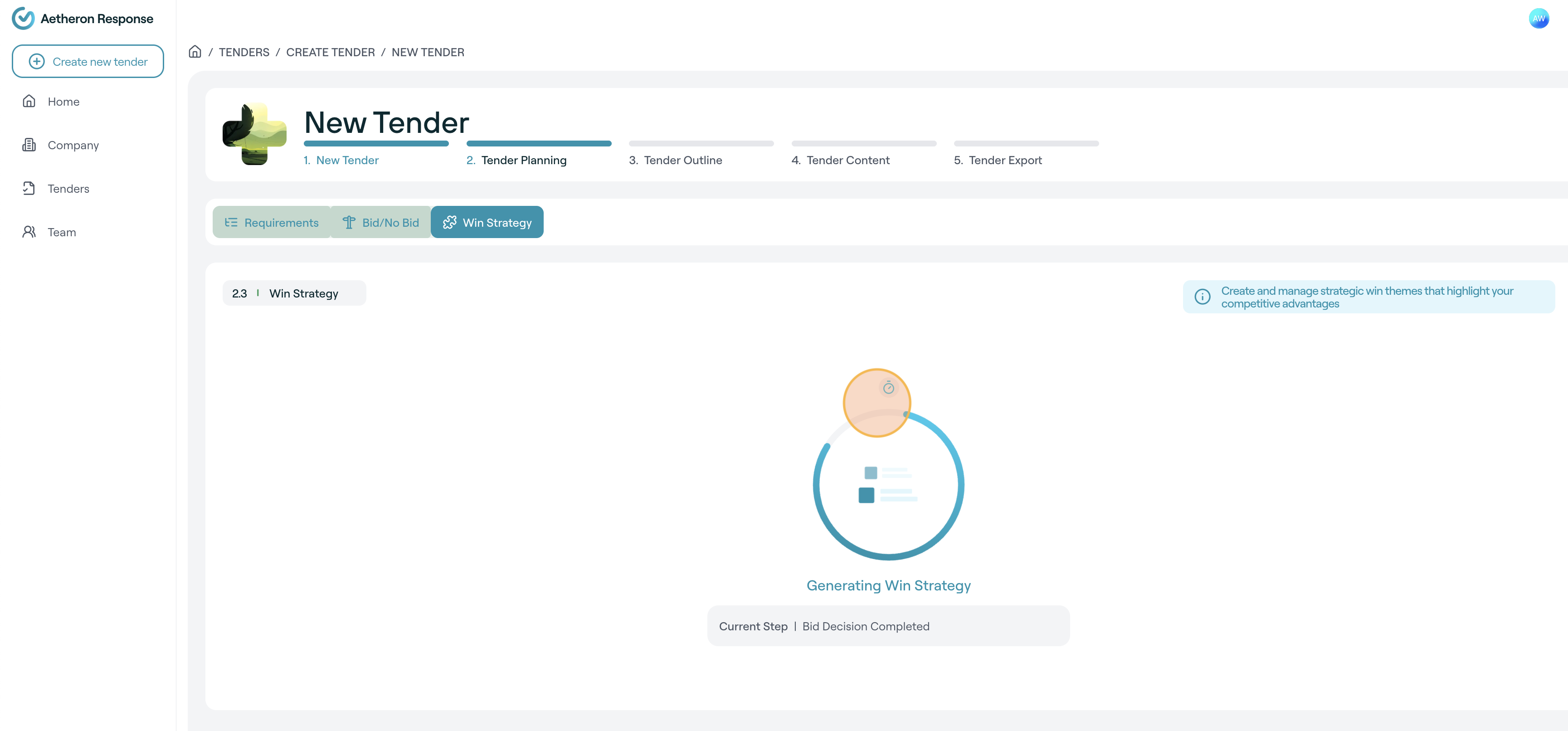
Recommended Win Themes
The AI suggests strategic themes such as:
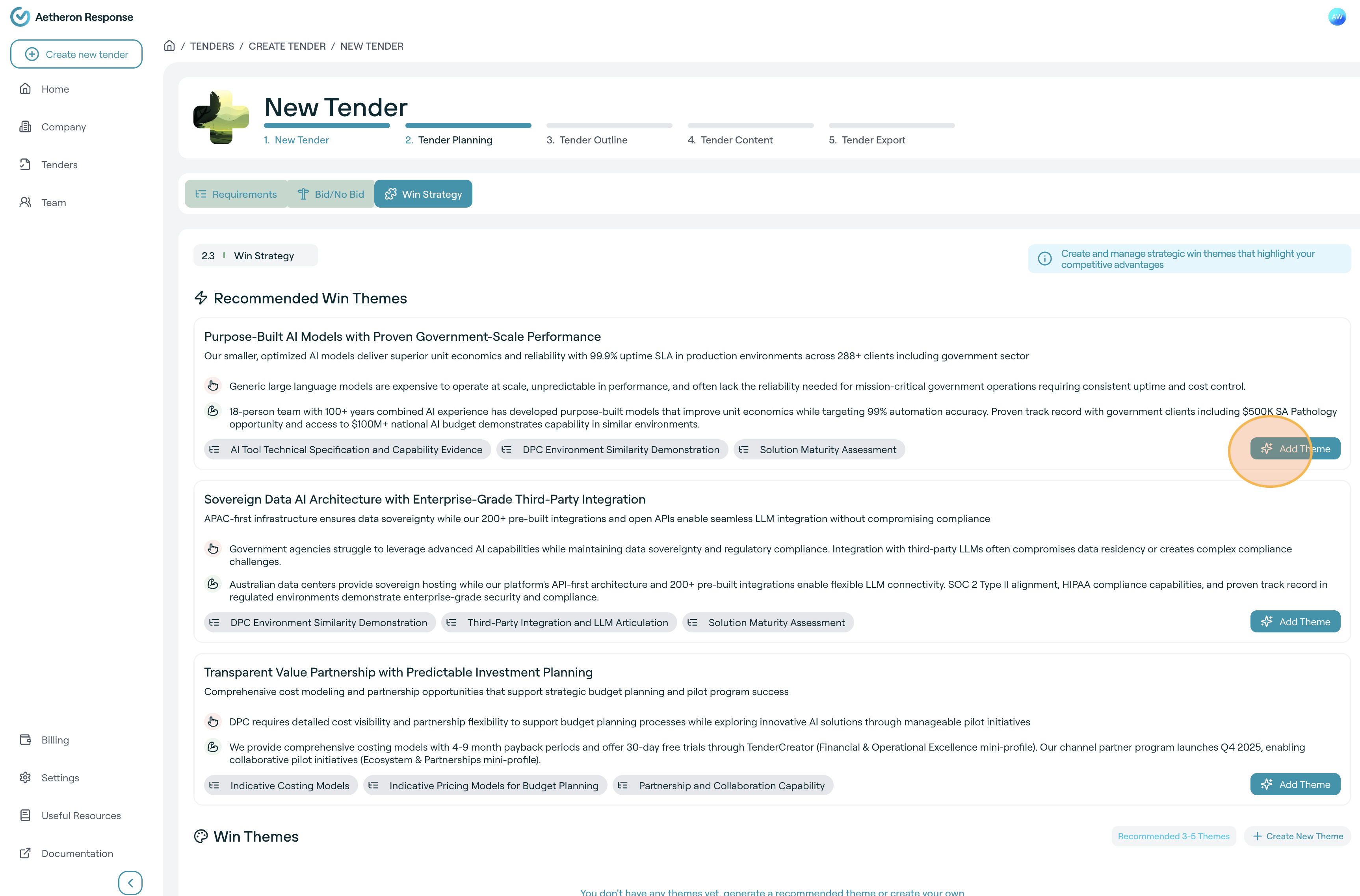
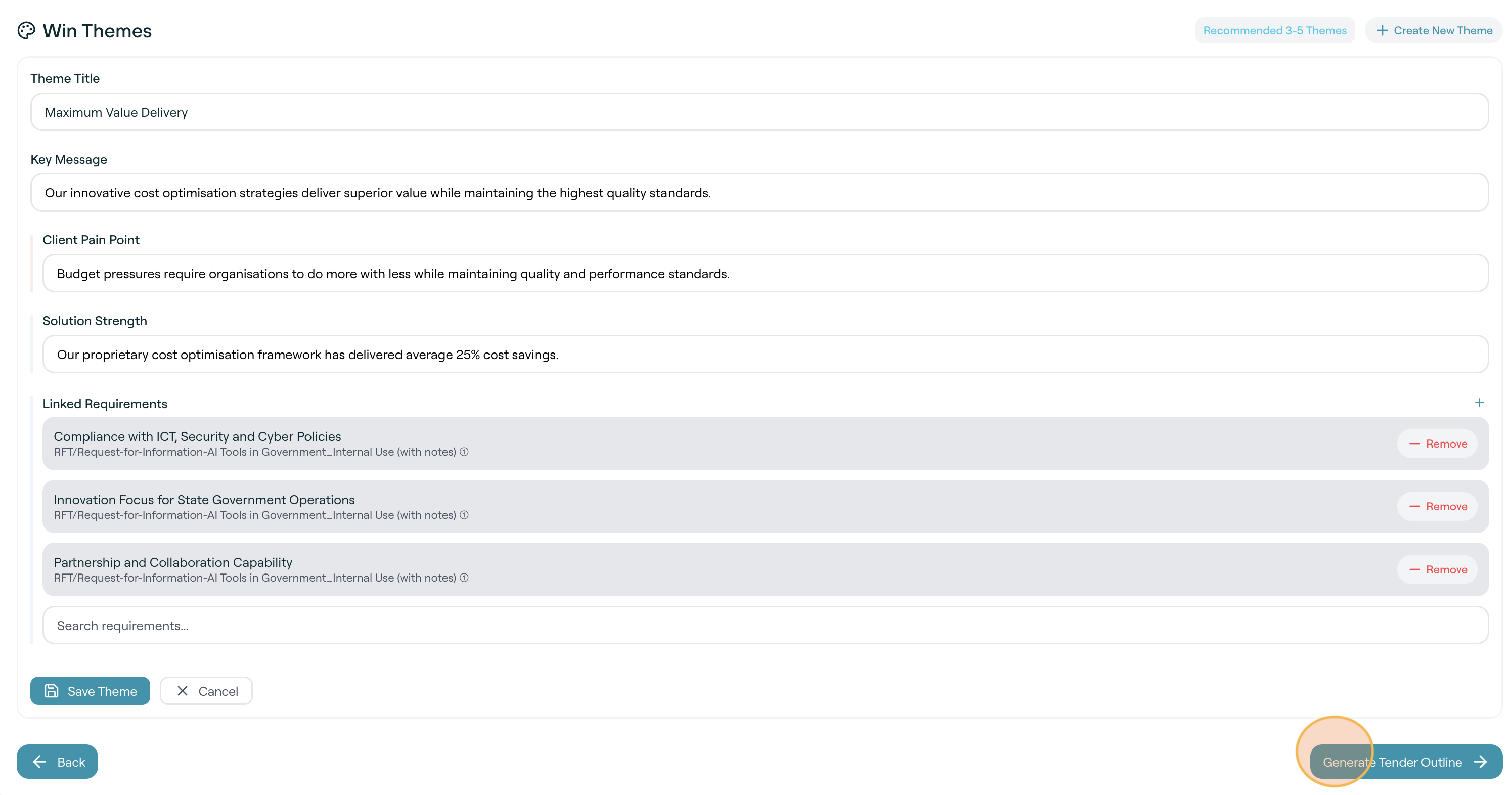
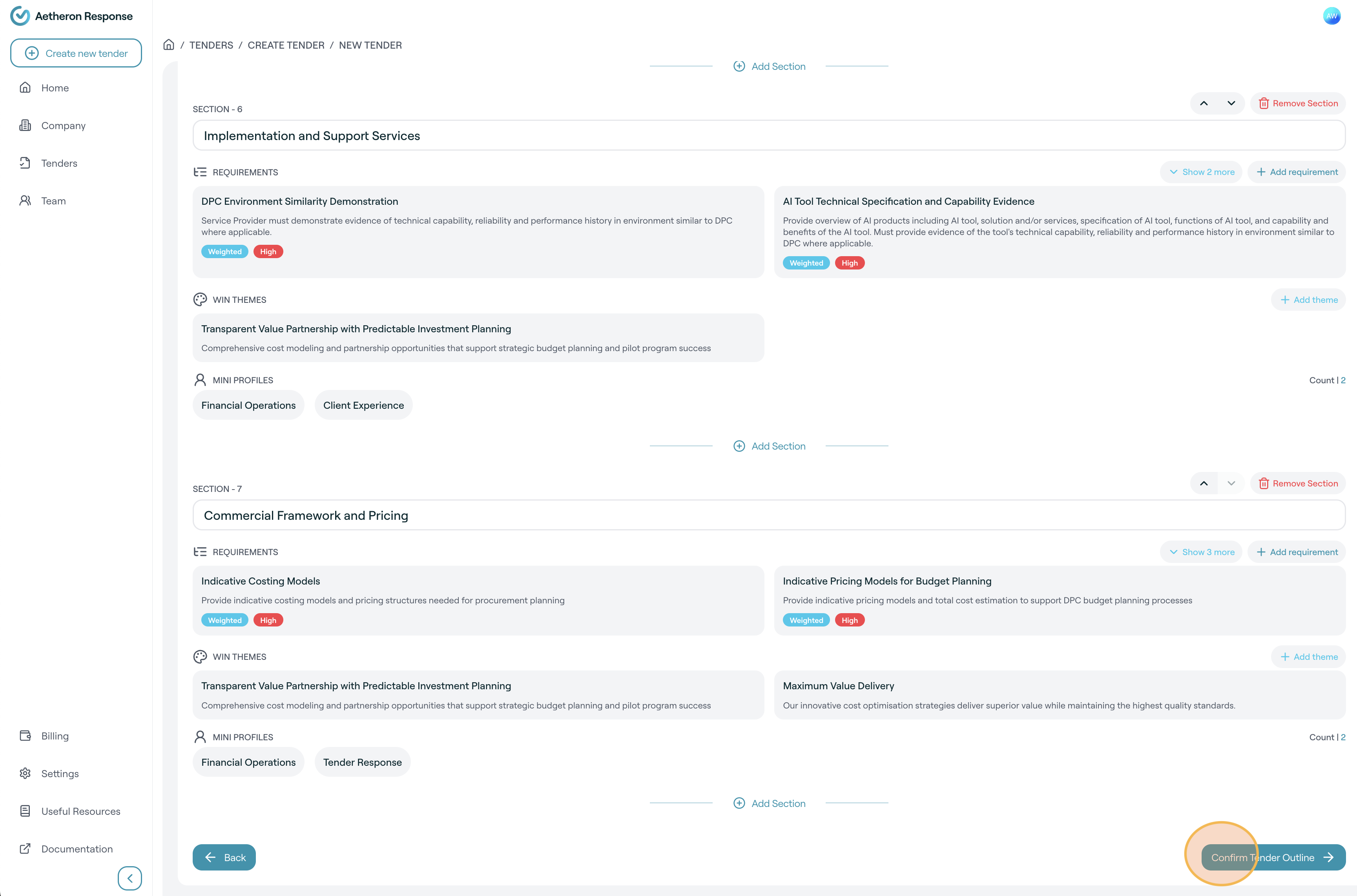
1. Unified Security-First Cloud Native Transformation at Scale
- Only provider with proven capability to simultaneously modernise 45+ locations with zero-trust architecture while maintaining 100% uptime during migration
- Unique unified security-first cloud native transformation at scale enables simultaneous modernisation of all 45 locations with zero-trust architecture while maintaining 100% uptime during migration
2. Continuous Service Excellence Partnership
- Deliver uninterrupted service availability with proactive support that transforms IT from a cost centre to a strategic enabler of government operations
- Limited 24/7 support coverage and manual processes create service vulnerabilities that could disrupt critical government services
3. Sovereign Cloud Architecture with Automated Compliance Orchestration
- Our sovereign-first cloud architecture delivers automated Essential Eight compliance with real-time security orchestration across Australian regions
- Manual compliance management across hybrid environments creates security gaps, audit failures, and operational overhead
4. Zero-Downtime Legacy Transformation with AI-Driven Risk Assessment
- Our AI-powered legacy assessment and phased migration methodology eliminates transformation risks while maintaining 99.99% uptime during transition
- Legacy system migrations typically cause significant downtime, unpredictable failures, and budget overruns due to hidden dependencies
Theme Components
Each theme includes:
- Value proposition: Clear benefit statement
- Differentiators: What sets you apart from competitors
- Evidence points: Supporting capabilities and experience
- Risk mitigation: How you address buyer concerns
Customising Win Themes
You can enhance the suggested themes:
- Edit theme content: Modify language and positioning
- Add specific examples: Include relevant project examples
- Strengthen differentiators: Enhance competitive advantages
- Remove irrelevant themes: Delete themes that don't fit
Win Theme Management
The interface allows you to:
- Add custom themes: Create additional strategic themes
- Reorder themes: Prioritise most important themes first
- Delete themes: Remove themes that aren't relevant
- Regenerate themes: Get fresh AI suggestions
Navigation and Progress Tracking
Planning Phase Navigation
The planning interface includes:
- Tab navigation: Switch between Requirements, Bid/No Bid, and Win Strategy
- Progress indicators: Visual completion status for each section
- Back/Forward buttons: Navigate between planning steps
- Save progress: Automatic saving of your work
Moving Forward in the Process
After completing planning:
- Review all sections: Ensure requirements, bid decision, and strategy are complete
- Make final adjustments: Refine any elements before proceeding
- Proceed to outline: Click "Proceed to Win Themes" or similar navigation button
- Begin outline phase: Move to tender outline development
Getting Back to Planning
If you need to return to planning:
- Use breadcrumb navigation: Click on planning phase in progress bar
- Access from outline: Most phases allow returning to previous steps
- Save current work: Ensure progress is saved before navigating away
Best Practices for Planning Phase
Requirements Review
- Read thoroughly: Don't rush through requirement validation
- Check for gaps: Look for requirements the AI may have missed
- Prioritise accurately: Ensure high-priority requirements are correctly identified
- Add context: Include internal notes about complex requirements
Bid Decision Process
- Be realistic: Honestly assess your capabilities and position
- Consider partnerships: Factor in potential strategic partnerships
- Evaluate resources: Ensure you have capacity to deliver if successful
- Review thoroughly: Check all assessment criteria for accuracy
Win Strategy Development
- Align with strengths: Ensure themes highlight your genuine advantages
- Address weaknesses: Include themes that mitigate competitive disadvantages
- Be specific: Use concrete examples and quantifiable benefits
- Stay focused: Limit to 3-5 strong themes rather than many weak ones
Troubleshooting Planning Issues
Requirements Not Extracting Properly
If requirements seem incomplete:
- Check RFT quality: Ensure document is readable and well-formatted
- Look for hidden sections: Some requirements may be in appendices
- Add manually: Include missing requirements in custom fields
- Contact support: Get help with complex document structures via our Support guide
Bid Assessment Seems Inaccurate
If the bid recommendation doesn't match your assessment:
- Review company profile: Ensure your profile completely represents capabilities
- Check requirement mapping: Verify your capabilities align with requirements
- Update profile content: Add missing information about your company
- Provide feedback: Help improve AI accuracy for future assessments
Win Themes Not Relevant
If suggested themes don't fit:
- Regenerate themes: Try getting new AI suggestions
- Edit extensively: Modify themes to better fit your situation
- Create custom themes: Develop themes from scratch if needed
- Review company profile: Ensure profile accurately represents your strengths
Updated 18 days ago
